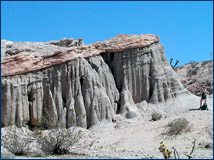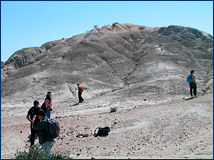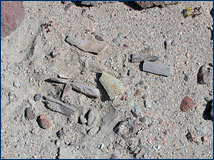 |
Red Rock Canyon State Park, California
by Jere Lipps
Located in Kern County 25 miles north of Mojave in the El Paso Mountains, Red Rock Canyon State Park preserves 27,000 acres of badlands made of Miocene terrestrial sedimentary rocks and interbedded basalt volcanic flows and ash beds. These rocks, deposited in streams and floodplains, consist of muds, sands and conglomerates, are part of the Dove Spring Formation formerly known as the Ricardo Formation. They range in age from 12 to 8 million years old and yield fossils of various vertebrates (horse, camel, antelope, saber-tooth cats, bone-crushing dogs, rodents, rabbits, insectivores, and others) as well as plant fossils (palms and grasses, but few leaves). Because of the desert conditions, the rocks are well exposed. They are tilted slightly because of motion on the nearby Garlock fault.
Red Rock Canyon State Park contains the most complete fossil record of vertebrates in North America of Clarendonian age and as such, can be considered one of the most important late Miocene localities in North America.


